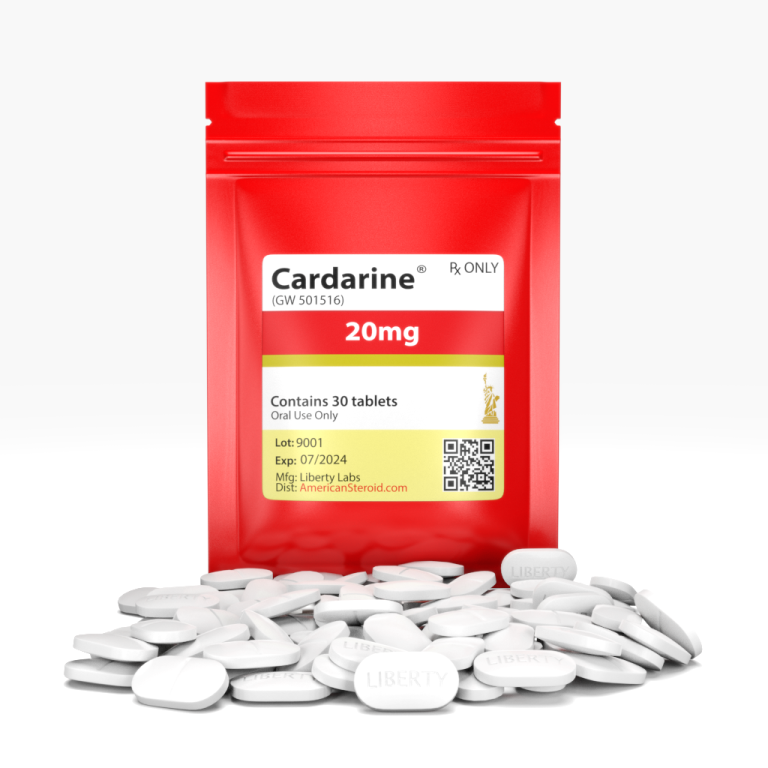CARDARINE (GW-501506): 20mg tablets. Each order contains 30 hard pressed tablets; tablets contain 20mg of Cardarine also known as (GW-501506).
Inactive ingredients: Microcrystalline cellulose, magnesium stearate, Silica Di Oxide, Di-calicum Phosphate and USP grade food coloring.
All of our products are laboratory tested. We are working to make test results available to our customers. When labs are available you will be able to find them here. Link to lab
Cardarine (GW-501516)
1. What It Does
Cardarine, also known as GW-501516, is a PPARδ (Peroxisome Proliferator-Activated Receptor Delta) agonist, often mistakenly grouped with SARMs (Selective Androgen Receptor Modulators). It was originally developed in the 1990s by GlaxoSmithKline (GSK) and Ligand Pharmaceuticals to treat metabolic and cardiovascular diseases.
Unlike SARMs, Cardarine doesn’t act on androgen receptors. Instead, it influences gene expression by activating PPARδ, a receptor involved in lipid metabolism, energy regulation, and endurance. When PPARδ is activated, the body increases its use of fat as a fuel source, leading to improved stamina and fat loss.
Mechanism of action:
Activates PPARδ receptors → increases fat oxidation and glucose utilization in skeletal muscle.
Mimics some effects of aerobic exercise by shifting the body’s metabolism toward endurance and fat-burning pathways.
2. Main Reported Benefits
Enhanced Endurance: Strong anecdotal and preclinical evidence supports significantly increased stamina and athletic performance.
Fat Loss: Promotes utilization of fatty acids for energy, often resulting in body fat reduction without muscle loss.
Improved Lipid Profile: Studies show lowered LDL cholesterol and increased HDL cholesterol in animal models.
Preservation of Muscle Mass: During cutting or calorie deficits, may help retain lean mass.
Better Glucose Control: May support insulin sensitivity and glucose metabolism.
No Hormonal Suppression: Since it doesn’t interact with androgen receptors, it doesn’t suppress natural testosterone production.

3. Normal Applications
Cardarine has been studied or used experimentally in the following ways:
Metabolic Disorders: Initially researched for its effects on obesity, type 2 diabetes, and dyslipidemia.
Cardiovascular Health: Explored as a therapy to improve heart health and cholesterol levels.
Athletic Performance: Widely used in research and underground bodybuilding circles for endurance enhancement and fat reduction.
Cutting Cycles: Commonly used to aid fat loss while preserving muscle during calorie restriction.
It is important to note that Cardarine is not approved by the FDA or similar regulatory bodies for any medical use in humans.
4. Common Side Effects
Cardarine is generally well-tolerated based on anecdotal reports, but concerns exist due to long-term toxicity findings in animal studies:
Potential Carcinogenic Risk: In a 2007 GSK study, rats developed cancer after high-dose, long-term exposure. However, the human relevance of this data at typical research dosages remains debated.
Headaches or Mild Nausea: Occasionally reported, especially at higher doses.
Joint Pain: Some users have reported discomfort, though not widespread.
Insomnia or Restlessness: Possibly due to increased metabolic activity and energy levels.
Because of the potential cancer risk observed in preclinical trials, development of Cardarine for human use was discontinued.
5. Recommended Administration or Dosage
Note: The following information is based on non-clinical reports and research community protocols. Cardarine is not legally approved for human consumption.
Dosage Range: 10–20 mg per day
Administration: Orally, once per day
Cycle Length: 6–8 weeks is common, followed by a break
Half-Life: ~16–24 hours, supporting once-daily dosing
Timing: Can be taken pre-workout for performance enhancement or at any consistent time for metabolic effects
There is no need for post-cycle therapy (PCT), as Cardarine does not affect hormone levels.
Final Notes and Disclaimer
Cardarine is a powerful PPARδ agonist that enhances fat oxidation and endurance. While it holds promise in metabolic and athletic applications, its development was halted due to cancer concerns in long-term animal studies. Despite its popularity in performance-enhancing circles, it remains a research chemical with no approved human use.


